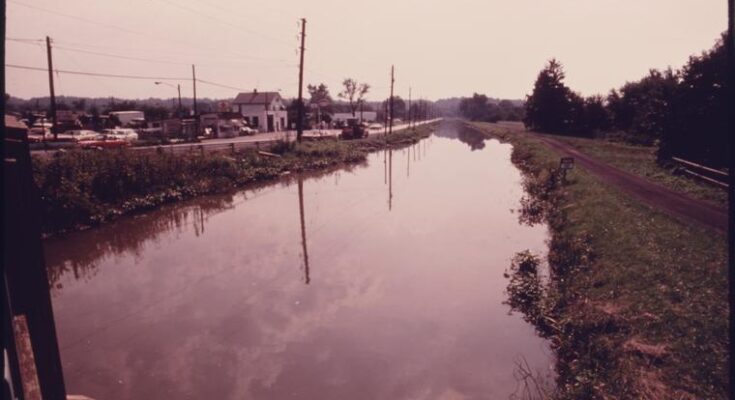1. Introduction to the Erie Canal
The history of the Erie Canal is a captivating tale of human ingenuity, perseverance, and the transformative power of infrastructure. Spanning over 363 miles across the state of New York, the Erie Canal stands as one of the most remarkable engineering achievements of the 19th century. This monumental waterway, connecting the Great Lakes with the Hudson River, played a pivotal role in shaping the economic, social, and cultural landscape of the United States. From its visionary inception to its lasting legacy, this article explores the fascinating journey of the Erie Canal, delving into its planning, construction, impact on trade and development, as well as the challenges faced and the canal’s present-day significance. Join us on a voyage through time, as we uncover the rich history of the Erie Canal.
1. Introduction to the Erie Canal
1.1 Defining the Erie Canal
The Erie Canal, often referred to as the “Big Ditch,” was a monumental waterway that stretched for 363 miles across the state of New York. It connected the Great Lakes and the Hudson River, providing a vital link between the agricultural heartland of the Midwest and the bustling markets of the East Coast.
1.2 Historical Context and Significance
The construction of the Erie Canal began in 1817 and was completed in 1825, marking a turning point in American history. At the time, transportation of goods faced numerous challenges, with land routes plagued by poor conditions and lengthy travel times. The Erie Canal revolutionized transportation by offering a reliable and efficient means to move goods, dramatically reducing costs and facilitating the growth of trade and commerce.
2. The Vision and Planning of the Erie Canal
2.1 Early Ideas and Proposals
The idea of building a canal to connect the Great Lakes to the Atlantic Ocean dates back to the early 18th century. Several proposals were put forward, but it was not until the early 19th century that serious consideration was given to the project. The growth of the Midwest and the need for better transportation spurred discussions on connecting the interior to coastal markets.
2.2 DeWitt Clinton and the Canal’s Advocacy
One of the key figures in the advocacy for the Erie Canal was DeWitt Clinton, a politician and statesman from New York. Clinton championed the canal project, recognizing its potential to revolutionize trade and transform the economic landscape. His persistent efforts and political influence were instrumental in garnering support for the canal’s construction.
2.3 Securing Funding and Political Support
Securing funding for the Erie Canal was no small feat. With estimates exceeding $7 million (equivalent to around $160 million today), skeptics questioned the feasibility and economic viability of the project. However, Clinton’s political savvy and persuasive arguments convinced the state legislature to authorize the necessary funds, and construction of the canal could finally begin.
3. Construction and Engineering Feats of the Erie Canal
3.1 Canal Route Selection and Surveying
Choosing the path for the canal was a complex task. Surveyors meticulously examined potential routes, considering factors such as terrain, elevation, and water sources. The final alignment of the canal navigated around natural obstacles, bypassing mountains and marshes whenever possible.
3.2 Overcoming Geological Challenges
The construction of the Erie Canal encountered various geological challenges, including rocky terrain and the daunting task of creating a waterway at high elevations. Ingenious engineering techniques, such as the use of explosives and advanced excavation methods, were employed to overcome these obstacles and ensure a navigable route.
3.3 Canal Locks and Aqueducts
One of the remarkable engineering feats of the Erie Canal was the construction of locks and aqueducts. Locks were built to control water levels and allow boats to navigate elevation changes along the canal. Aqueducts, on the other hand, enabled the canal to span rivers and valleys, ensuring an uninterrupted water passage.
4. Impact on Trade and Economic Development
4.1 Opening New Transportation Routes
With the completion of the Erie Canal, a new era of transportation was born. The canal created a direct water route from the Great Lakes to the Atlantic Ocean, bypassing the treacherous journey around the tip of South America. This significantly reduced travel time and costs for shipping goods, opening up vast trading opportunities.
4.2 Boosting Trade and Commerce
The Erie Canal quickly became a bustling thoroughfare, facilitating the transportation of a wide range of goods, including agricultural products, raw materials, and manufactured goods. This increased accessibility and lowered costs of transportation stimulated trade and commerce, fueling economic growth in both rural and urban areas.
4.3 Regional Economic Expansion
The impact of the Erie Canal on regional economic expansion cannot be overstated. It spurred the growth of towns and cities along its route, as businesses flourished and populations surged. The canal transformed New York into a major commercial center, positioning the state as an economic powerhouse and laying the foundation for its future development.
So there you have it – the fascinating history of the Erie Canal, from its visionary conception to its remarkable impact on trade and economic development. It’s a testament to human ingenuity and persistence, and a reminder that sometimes, a big ditch can make a world of difference.
5. Social and Cultural Transformation Along the Erie Canal
5.1 Canal Towns and Boomtowns
When the Erie Canal was completed in 1825, it sparked a wave of development along its route. Towns along the canal quickly transformed into bustling canal towns, experiencing a surge in population and economic activity. These canal towns became boomtowns, attracting merchants, entrepreneurs, and settlers looking for new opportunities. As trade flourished, businesses sprang up, including mills, warehouses, and hotels, catering to the needs of the canal travelers. The canal towns became vibrant centers of commerce and culture, shaping the social fabric of the region.
5.2 Immigrant Labor and Population Shifts
The construction and operation of the Erie Canal brought about significant changes in population demographics. The demand for labor to build and maintain the canal attracted a large influx of immigrants, particularly Irish and German workers. These immigrants played a crucial role in the canal’s success, working on the construction crews and later settling in the canal towns. The Erie Canal became a symbol of opportunity and a gateway to new beginnings for many immigrants seeking a better life in America.
5.3 Canal Culture and Entertainment
Life along the Erie Canal was not just about hard work and economic activity. Canal culture emerged, characterized by a unique blend of diverse influences. Boats traveling the canal brought people from different regions, bringing their customs, languages, and traditions. As a result, canal towns became melting pots of cultures, creating a rich tapestry of music, food, and celebrations. Entertainment abounded, with canal boats hosting lively dance parties and performances. The canal also spurred the growth of recreational activities, such as boating, fishing, and picnicking, providing moments of leisure and relaxation for canal travelers.
6. Challenges and Obstacles Faced during the Canal’s History
6.1 Financial Struggles and Cost Overruns
Building the Erie Canal was no easy feat, and financial challenges plagued its construction. The original estimated cost of the canal was significantly exceeded, leading to funding gaps and financial struggles. However, innovative financing methods, such as borrowing against future toll revenue and public subscriptions, helped overcome these obstacles. Despite the financial setbacks, the Erie Canal proved to be a wise investment, as its economic benefits far outweighed the initial costs.
6.2 Engineering and Technical Difficulties
Constructing a 363-mile-long canal in the early 19th century presented numerous engineering and technical challenges. The canal had to navigate challenging terrain, including elevations, swamps, and rivers. Innovative engineering solutions were developed, including the use of locks to overcome elevation changes and the creation of a canal prism for efficient water flow. However, even with these engineering marvels, the canal faced issues such as leaks, floods, and winter freezing, requiring ongoing maintenance and improvements.
6.3 Opposition and Legal Battles
Not everyone embraced the Erie Canal with open arms. Opposition to the project came from various fronts, including landowners, rival transportation interests, and skeptics who doubted its feasibility. Legal battles ensued, with lawsuits challenging the canal’s construction and operation. Despite the opposition, the canal’s benefits and undeniable success eventually silenced many critics, cementing its place in history.
7. The Decline and Legacy of the Erie Canal
7.1 Railroad Competition and Canal Obsolescence
The rise of the railroad in the mid-19th century posed a significant challenge to the Erie Canal. Railroads offered faster and more reliable transportation, gradually making canals less economical and efficient. The decline of the canal as a main transportation route was inevitable, leading to decreased traffic and economic activity along its once-bustling shores. However, the impact and legacy of the Erie Canal lived on, as it had already transformed New York State and set the stage for future transportation developments.
7.2 Preservation Efforts and Historical Importance
Recognizing the historic significance of the Erie Canal, preservation efforts began in the 20th century to protect and commemorate its legacy. Historic canal structures, including locks and aqueducts, were restored, and museums dedicated to the canal’s history were established. The Erie Canal’s role as a catalyst for economic growth and social change in America’s history is now widely acknowledged, further fueling preservation efforts and historical appreciation.
7.3 The Erie Canal as a Tourist Attraction
Despite its diminished transportation role, the Erie Canal remains a popular tourist attraction. People from all over the world come to experience the canal’s scenic beauty, explore historic canal towns, and take leisurely boat tours. The canal’s towpath has been repurposed as a recreational trail, offering opportunities for walking, cycling, and leisurely strolls along its historic route. The Erie Canal continues to captivate visitors with its rich history, picturesque landscapes, and enduring charm.
8. The Erie Canal Today: Preservation and Recreation
8.1 Maintaining and Restoring the Canal
Efforts to maintain and restore the Erie Canal continue to ensure its preservation for future generations. The New York State Canal Corporation oversees ongoing maintenance, including dredging, repairing canal walls, and maintaining locks and structures. Restoration projects aim to recreate the canal’s historic appearance, ensuring that its legacy endures.
8.2 Canal as a Recreational Waterway
While the Erie Canal is no longer a major transportation artery, it has found new life as a recreational waterway. Boaters can navigate various sections of the canal, enjoying the tranquil waters and picturesque landscapes. The canal’s locks add an element of adventure and exploration, allowing boaters to experience the engineering marvels of the past firsthand.
8.3 Cultural and Educational Interpretation
The Erie Canal serves as a living classroom where visitors can learn about its history, impact, and cultural significance. Museums, interpretive centers, and educational programs along the canal provide opportunities for people of all ages to delve into its rich past. The canal also hosts various events and festivals, celebrating its heritage and fostering a sense of community among those who appreciate its historical importance.
The Erie Canal may have faced challenges throughout its history, but its impact on American society and its legacy as a technological marvel and cultural icon remain undeniable. As long as there are people who appreciate its historical significance and recognize its continued value, the Erie Canal will continue to be preserved, celebrated, and enjoyed for generations to come.In conclusion, the Erie Canal remains an enduring symbol of innovation and progress. Its construction and operation not only facilitated trade and economic growth but also sparked social and cultural transformations along its banks. While the canal’s prominence has diminished over time, it continues to hold a special place in history and serves as a testament to human determination and engineering prowess. Today, the Erie Canal stands as a cherished recreational waterway and a living reminder of the past. As we reflect on its legacy, let us appreciate the profound impact of this remarkable feat of engineering that forever changed the course of American history.
FAQ
1. What was the purpose of the Erie Canal?
The primary purpose of the Erie Canal was to provide a navigable water route that connected the Great Lakes region with the Atlantic Ocean via the Hudson River. This canal was envisioned as a transportation artery to facilitate trade, promote economic development, and provide a faster and more efficient route for goods and passengers.
2. How did the Erie Canal impact the growth of New York City?
The Erie Canal played a crucial role in the growth and prosperity of New York City. By connecting the city with the vast resources of the Midwest, the canal transformed New York into a major trade hub. It allowed goods to be transported quicker and cheaper, leading to an exponential increase in trade, industry, and population. This rapid growth propelled New York City to become the financial and commercial capital of the United States.
3. What were some of the engineering challenges faced during the construction of the Erie Canal?
The construction of the Erie Canal presented several engineering challenges. One of the major challenges was the need to overcome the significant elevation differences along the route. To address this, a system of locks and aqueducts was built to raise and lower the water levels, allowing boats to navigate the varying terrain. Additionally, the canal had to traverse through challenging landscapes, including dense forests, rocky terrains, and marshy areas, requiring extensive excavation and cutting-edge construction techniques for its successful completion.
4. Is the Erie Canal still in use today?
While the Erie Canal is no longer used for commercial transportation to the extent it once was, it continues to serve as a recreational waterway. Many sections of the canal have been preserved, offering boating, fishing, and biking opportunities for locals and visitors alike. The Erie Canalway Trail, a multi-use path along the canal, allows people to explore and enjoy the scenic beauty and historical significance of this iconic waterway.



